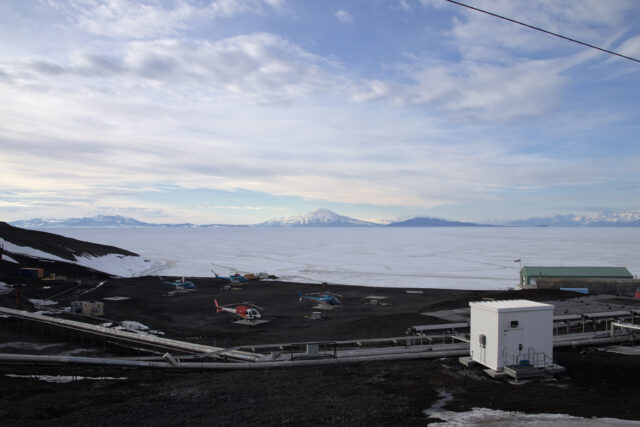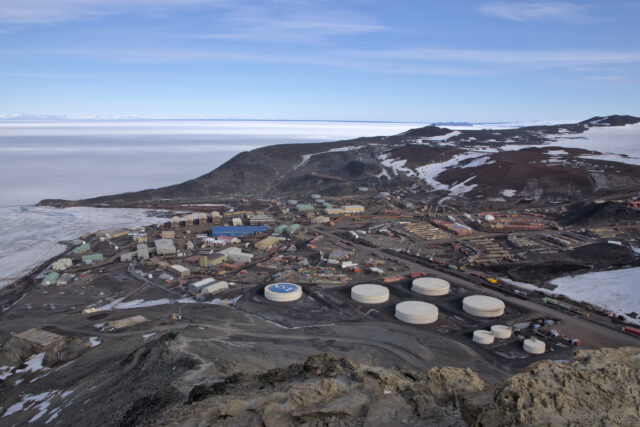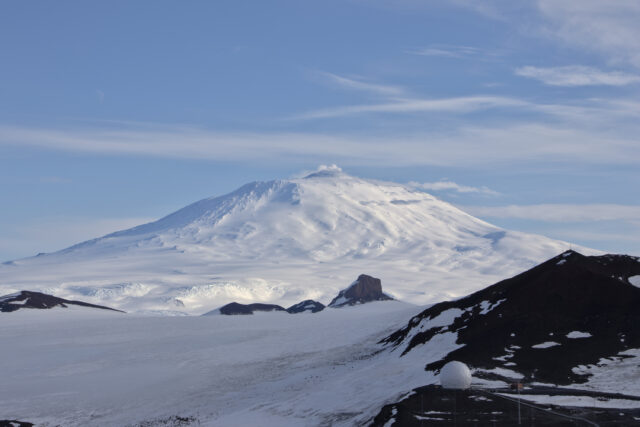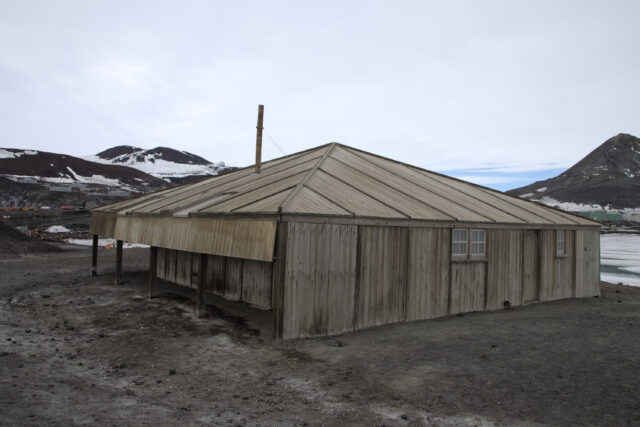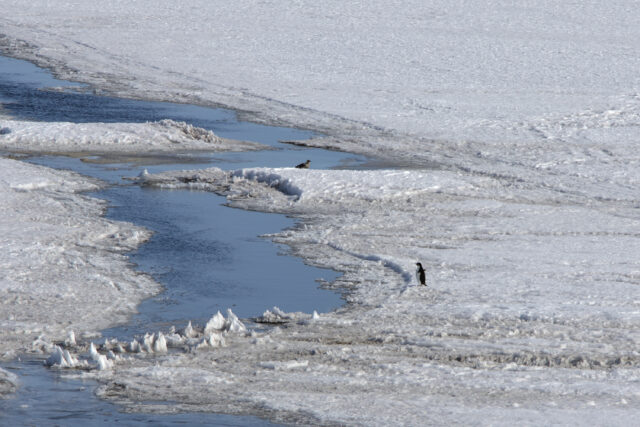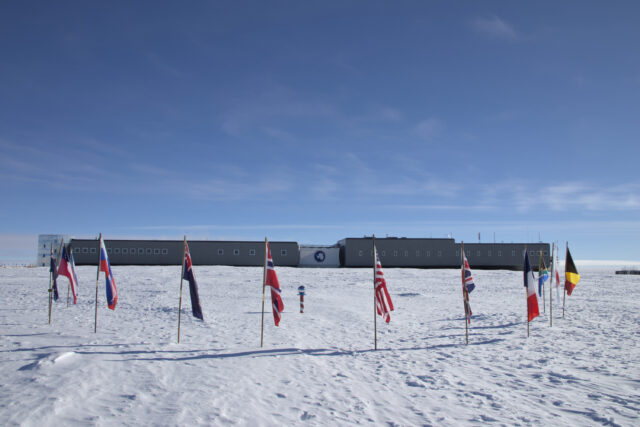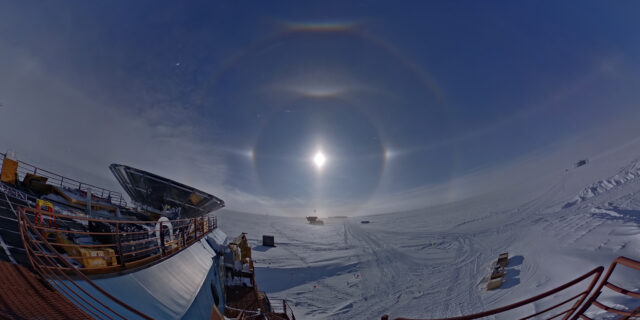This past austral summer, I was fortunate enough to be able to spend two months in Antarctica working on the BICEP / Keck telescopes under the United States Antarctic Program (USAP).1 Due to limited deployment slots, I was originally on a list of alternates, who also completed the rigorous physical qualification (PQ) process, and found out that I would deploy shortly before Thanksgiving—roughly two weeks before I left—after a slot opened up on the primary deployment roster.
As one might imagine, getting to Antarctica is difficult, both due to the remoteness and the harsh environment. To start, I flew commercial from Boston to Christchurch, New Zealand, via San Francisco and Auckland, which requires 19–20 hours of flights, plus layovers.2 The next day, I arrived at USAP’s clothing distribution center (CDC), just outside the Christchurch airport, for COVID testing, a brief introductory presentation, and to try on the program-issued extreme cold weather (ECW) gear. At this point, we learned that our “ice flight,” our flight from Christchurch to McMurdo Station, was scheduled for three days later. McMurdo Station is the largest research station in Antarctica, and it serves as USAP’s primary base on the continent; all personnel and cargo headed to the South Pole pass through McMurdo. All personnel head to McMurdo, as well as New Zealand’s adjacent Scott Base, pass through Christchurch. While we had a couple days in Christchurch, we were under strict isolation instructions due to COVID, although I did get to walk downtown and see the lovely Christchurch Botanical Garden.
After some additional training held online and another COVID test the day before our flight, we were ready to depart. The day started with waking up well before dawn and calling the flight status hotline to ensure the flight was not delayed. Due to the harsh and unpredictable environment, flights are frequently delayed due to weather or mechanical issues. Upon arrival at the CDC, we donned our full ECW—in case of a flight emergency—and proceeded to check in. We were weighed along with our luggage, such that extra cargo could be added right up to the weight limit. Most of our cargo was packed onto pallets, with the exception of a small carry-on bag. One checked bag was designated a “boomerang bag,” which we would get back in case the weather deteriorated at McMurdo and the flight had to “boomerang” and return to Christchurch, becoming a very long flight to nowhere. There was then enough waiting time to grab something for breakfast at the nearby supermarket, after which we were bussed onto the tarmac to board our flight. As I was flying in early-to-mid December, this was on an NZDF C-130 aircraft; early in the season, flights are primarily on USAF C-17 aircraft, but as temperatures rise and the runway softens, this switches to lighter NZDF C-130 aircraft and finally to ski-equipped NY ANG LC-130 aircraft. Next came the >7 hour flight to McMurdo, which, while uneventful, was loud, uncomfortable, and packed full with both personnel and cargo pallets. As we proceeded south, sea ice began to appear, and then we finally saw the outer reaches of the Antarctic continent (the C-130 only has a few small windows, so folks had to take turns looking out).
Finally, we landed at Phoenix Airfield on the McMurdo Ice Shelf and were then driven to McMurdo Station in the Kress Transporter for our arrival briefing. In the summer, the air temperature at McMurdo hovers around freezing, so a flannel shirt, fleece jacket, and windbreaker—along with a wool hat and gloves—were enough to stay comfortable outside (at least if one wasn’t just standing around). After an initial “night” in Building 140,3 we were tested for COVID again, and I then settled into my home for the next two weeks, a room in the Hotel California (HoCal) dorm, with a lovely view of McMurdo Sound, Mount Discovery, and the Royal Society Range.
We were scheduled for five days of quarantine, but once that was up, the weather finally improved at the West Antarctic Ice Sheet (WAIS) Divide field camp, after the better part of a month, so the LC-130 aircraft were prioritized for trips there. The South Pole was a backup destination the entire week, which meant in addition to not flying, we also had to live out of our single carry-on bag, since the rest of our luggage was on pallets ready to be loaded should the weather at WAIS deteriorate. Although unplanned and uncertain, the extended stay in McMurdo was not all bad, as I got to go hiking in the vicinity of McMurdo; see Discovery Hut, built for Scott’s Discovery expedition and also used for his ill-fated Terra Nova expedition; and see the launch of the SPIDER balloon-borne telescope. For the latter, we were not allowed to take the shuttle vans out to the Long Duration Ballooning (LDB) facility for the launch as we were quarantining, so I borrowed a fat-tire bike and biked the 13–14 miles round trip to near the LDB facility and Williams Field, a.k.a. Willy Field, to get a closer view of the launch. I also got to see plenty of seals and skuas,4 as well as a single Adélie penguin off Hut Point, probably the first Spheniscidae visitor of the season.
As we had still not flown by December 23, we were stuck for the weekend. Normally, Saturday is a work day in Antarctica, but Christmas was observed on the 24th, so in addition to there being no flights, we also couldn’t take part in the festivities as we were in isolation. On Monday, we were finally the primary flight and were driven to Willy Field for our flight to the Pole.5 After a few hours waiting around the airfield for mechanical issues with the LC-130 aircraft to be addressed,6 we boarded the aircraft and began to taxi. Unfortunately, the aircraft was still having issues with its hydraulics, so we deplaned and returned to McMurdo for another night. On Tuesday, December 27, we returned to Willy Field. During the ride to the airfield, it was unclear if the weather would hold, but it ended up cooperating and we quickly boarded the LC-130 soon after we arrived and departed for the South Pole.
After a three-hour flight, we landed at Amundsen–Scott South Pole Station’s Jack F. Paulus Skiway and taxied to the ramp adjacent to the station, where we deplaned with the props still spinning as the cold makes it difficult to start the engines. Here, the weather was much colder, so the ECW gear was very much necessary; it is also very, very, very dry. After an arrival briefing and lunch, I went straight to work, helping with the installation of a detector module that a colleague on my flight had carried. Other than the day I left in February, I went out to the “Dark Sector,” which has restrictions on radio transmitters, to work on the telescopes every day, specifically in the Dark Sector Laboratory (DSL) and Martin A. Pomerantz Observatory (MAPO) buildings. In addition to assembly, installation, and calibration work on BICEP receivers, I also overhauled the computers running the BICEP3 telescope, which was the primary reason for me to deploy.
The South Pole Station is located at ~2800 m (~9300′) elevation, on the desolate Polar Plateau, with nothing besides the Station for hundreds of miles. Despite the extreme conditions outside, life in the current elevated station is pretty normal, once you get used to the fact that the sun never sets during the summer. Meals are served in the galley, although without any fresh fruit or vegetables most of the time, and the berthing wings consist of single-occupancy dorm rooms, albeit very small ones. There’s a science lab, gym, post office, store, medical clinic, laundry room, music room, arts & crafts room, sauna, greenhouse, and a couple lounges. However, there’s severe water rationing, with a limit of four minutes of shower water a week, typically a pair of two-minute showers, and one load of laundry. Internet access is also extremely limited; depending on which—if any—geostationary satellite is visible, it ranges from very slow and high latency to practically unusable to no access at all.7 Although I missed Christmas dinner being stuck in McMurdo, I did get to attend the New Year’s Eve party, held outside due to COVID, and the yearly Geographic Pole remarking ceremony on New Year’s Day.8 Thanks to the unique weather, sun dogs and related atmospheric optical phenomena are frequently visible.
As the end of the summer season neared in February, temperatures began to dip below −40°, with the wind chill pushing it significantly lower. I left the Pole on an LC-130 on February 15, the last flight out for the season, with around two dozen others; due to the extreme cold, there are no flights in or out until late October or early November, and the 40-ish people on the Station right now are isolated from the rest of the world. After arriving at Willy Field at McMurdo, we took “Ivan” the Terra Bus straight to Phoenix Airfield to wait for our flight to Christchurch. Our C-17 landed during the drive between the airfields, and after waiting a couple hours on the ice waiting for cargo to be unloaded and loaded, including a helicopter, we boarded the aircraft for a five-hour flight off the Ice.9
Upon arriving in Christchurch, it was dark and raining, a significant change from Antarctica. In addition to the sound of the rain, the humidity, the sounds of birds and insects, and the presence of smells10 are the drastic differences one notices upon leaving the Ice. After returning my ECW gear at the CDC and arriving at my hotel very late, I took a very long hot shower and went to bed. I had arranged for two extra days in Christchurch, so the next morning I booked a hotel room for the next two nights; the hotel room for the initial night was booked for me by USAP, and given the prevalence for flight delays to and from Antarctica, making arrangements in advance is risky. The first day, I visited the Christchurch Botanical Garden a second time, visited the Christchurch Art Gallery, and took a public bus out to go hiking in the Port Hills between Christchurch and Lyttelton. The next day, I took a bus to Lyttelton and a ferry across Lyttelton Harbour to Diamond Harbour and hiked to the summit of Mount Herbert, the tallest peak on the Banks Peninsula. The scenery was gorgeous, although it did rain a bit that morning. The next day was the long return trip to Boston.
I’ve uploaded more photos of both Antarctica and New Zealand to albums on Flickr.
And, yes, I got back almost six month ago and am just writing this blog post now. ↩
I had a very long layover in Auckland, although this did allow me to take public transit downtown and see parts of Auckland. ↩
The sun never set in my two months in Antarctica. ↩
Skuas are essentially large brown seagulls. ↩
Phoenix Airfield is a compacted-snow runway used for wheeled aircraft, while Willy Field is a skiway used for ski-equipped aircraft. ↩
We fortunately could spend time in the airfield galley and also got a tour of the control tower. ↩
Besides 24/7 email access on certain shared accounts, over Iridium. ↩
Due to movement of the ice sheet, the location of the Geographic South Pole moves relative to the Station. ↩
Unfortunately, this meant I did not get to see any more penguins. ↩
Not smelling much at the South Pole is probably a good thing, given the dearth of showers. ↩





